10 Free SKU Generator Tools For Creating SKUs Quickly & Efficiently
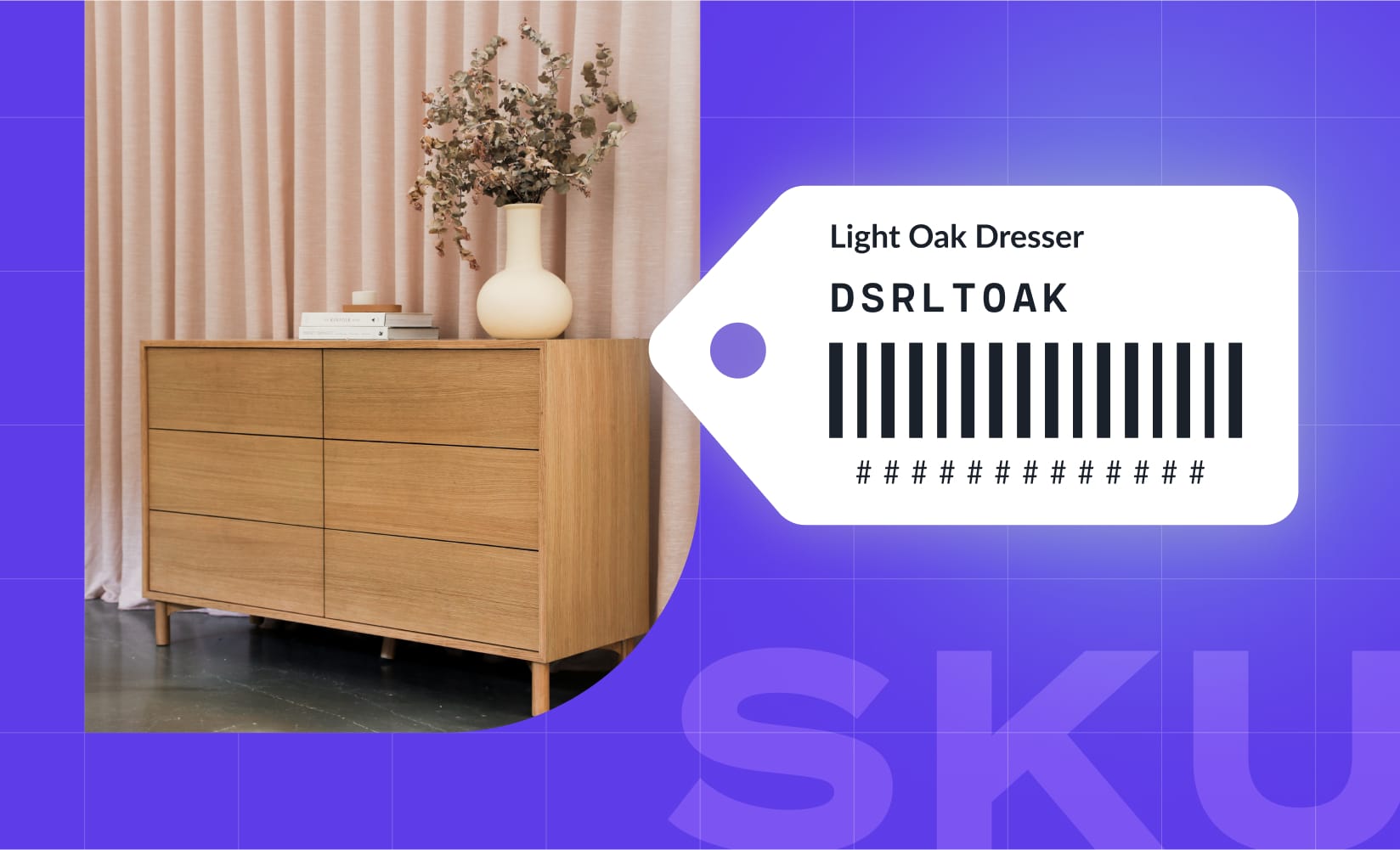
Business growth is always exciting. As your business scales and generates more and more revenue, you may find your catalog expanding to accommodate the influx of demand.
Complementary accessories and new product lines can help capture more market share from your competitors.
While growth is a good thing, rapid growth can lead to SKU proliferation.
If you’re not already using a SKU generator and an established process to track products internally, you could be losing money.
The more products you carry, the more likely you are to have mispicks and lost inventory along with a host of other problems related to your inventory.
Human error is the number one issue in 46% of warehouses.
That’s why so many brands are refining their processes for SKU generation as well as improving internal tracking systems.
Using a SKU generator and improving your SKU generation process early on reduces the potential for errors.
In this article, we’ll discuss:
Read on to learn how better SKU management can optimize inventory control and logistics operations.
#cta-visual-pb#<cta-title>Organize your SKUs and your storefront<cta-title>Use Shogun to create beautiful product pages for each SKU so they can start flying off the shelf.Start building for free
What is a SKU?
SKU (pronounced ‘SKEW’) is short for Stock Keeping Unit.
Retail and online stores use SKU numbers to reference products and track inventory in an organized way across all sales channels.
A SKU is made up of alphanumeric characters and is designed to be unique to a single product listing, down to each variant.
It’s important to note that the SKU is not the same as a product’s UPC, though retailers sometimes mistakenly use the UPC as the product SKU in their system.
We’ll get into how these differ later.
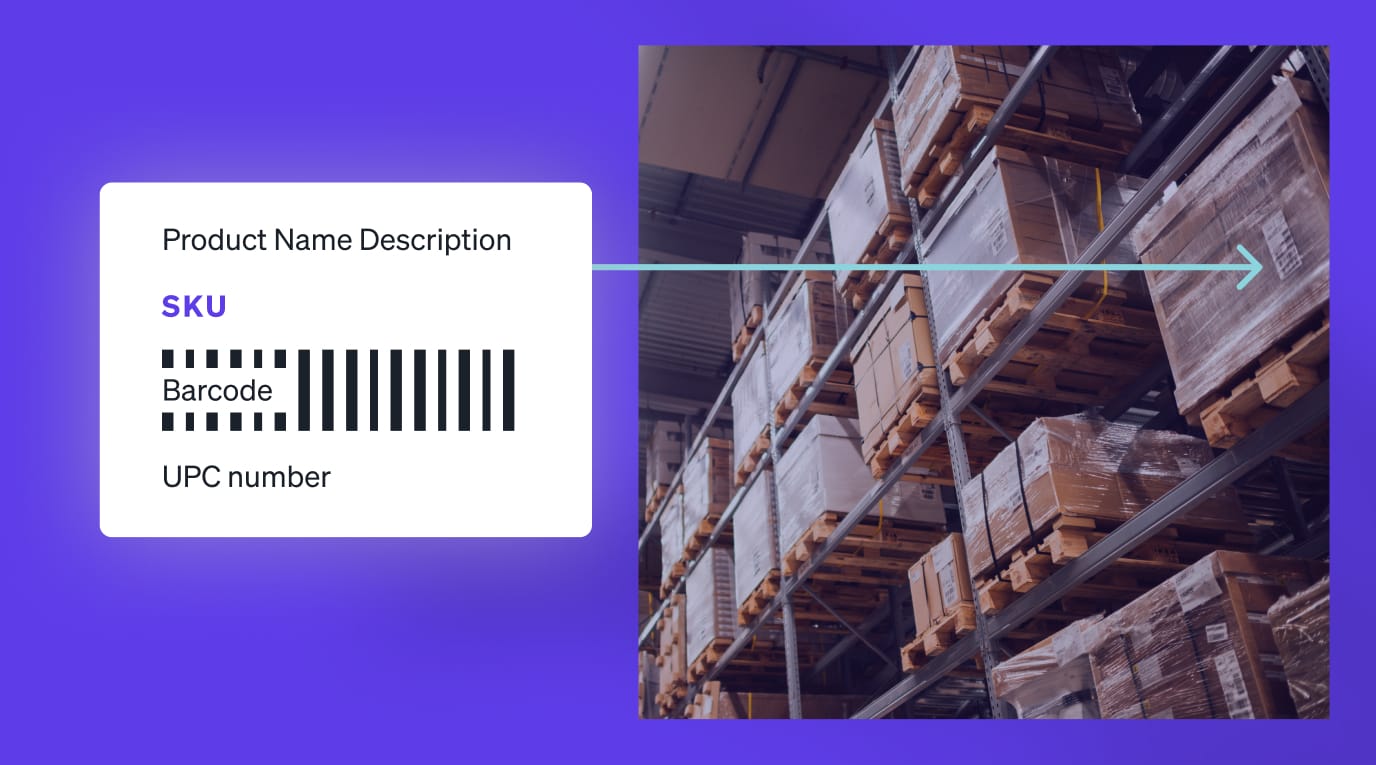
SKUs can be random combinations of letters and numbers, but usually, the characters have specific meanings.
More often than not, the characters identify key information about that product. For example, they could stand for attributes like:
- Brand
- Style
- Color
- Pricing
- Size
- Gender
- Item number
- Product code
- Category code
Ideally, the product details included in each SKU are ordered from most important to least important.
So, if your company sees product type as more important than color, then the characters representing the product type would go before the color.
For example, in the SKURGO-CS-S-W-RD:
- RGO = Brand
- CS = Product
- S = Size
- W = Gender
- RD = Color

A SKU number is generated on the backend of your online store for your own organization, but they can also be printed on physical product barcodes along with UPC numbers.
Therefore, your customers may or may not see this number.
You can potentially have it printed on the product packaging. In that case, it would only be looked at by customers if they have a problem with the product or would like to make a return.
In short, a SKU is a unique number assigned to each of your products.
SKU numbers are meant to be unique to your own business, so they aren’t universal or useful to other businesses.
SKU vs UPC: What’s the difference?
The UPC (Universal Product Code) is a universal code established by the Global Standards Organization.
This code identifies the manufacturer or brand and then the item. It’s a purely numeric code.
A SKU, on the other hand, is an internal code created and managed by the retailer (you) in an internal system specifically to identify product traits and differentiate products from one another.
A well-designed SKU should provide the most critical information about a product.
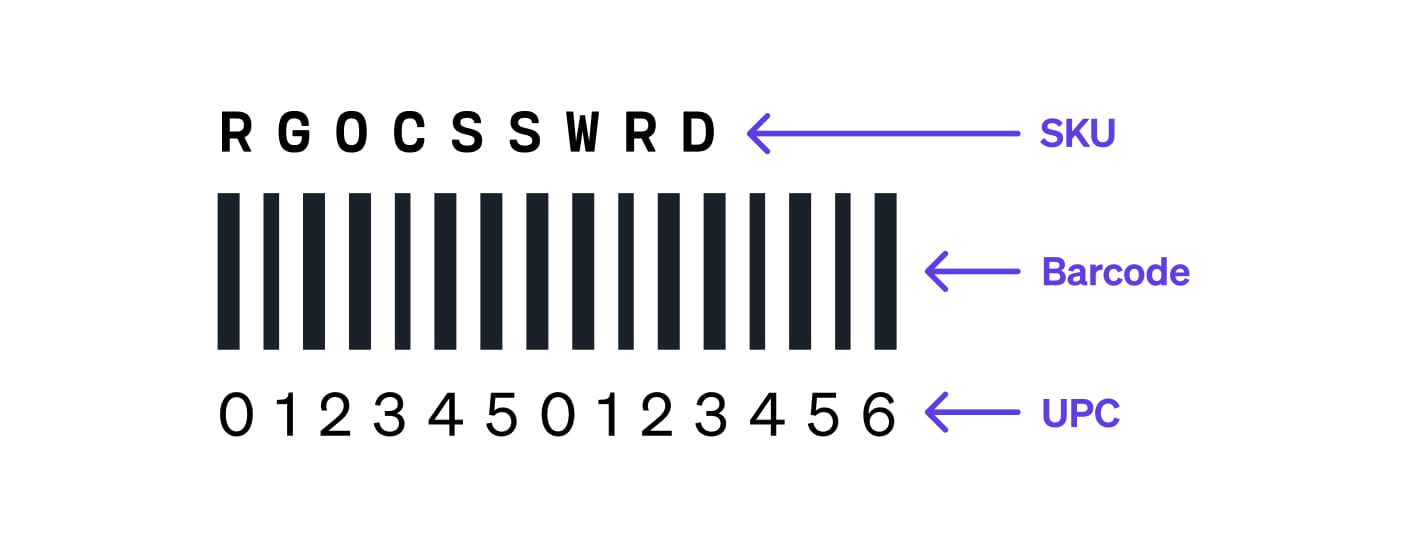
The importance of SKU management
SKUs are essential for providing data about your inventory that helps track business growth, nurture vendor relationships, and enhance your buyer experience.
Having well-managed and strategic SKUs helps with:
- Tracking growth: Being able to get an overview of your product lines and variations at a glance.
- Vendor relationships: Maintaining accuracy when it comes to purchasing, replenishment, and availability.
- Buyer experience: Ensuring accurate deliveries and stock counts available for sale.
Ultimately, good SKU management is good inventory management, and good inventory management means smooth operations.
So, you might be wondering how to create SKU numbers so you can start organizing your inventory the right way.
The easiest way is to use a SKU generator, which brings us to our next question.
What is a SKU generator?

There are two ways to create the SKUs for your ecommerce store: manually or automatically with a SKU generator.
Creating SKUs manually is tedious and prone to human error. Recording and tracking each sequence of characters takes time that could be better spent elsewhere. This is particularly true for large stores.
On the other hand, a SKU generator can remove the tediousness of the SKU creation process, while enhancing accuracy and efficiency.
A good SKU generator automatically creates SKUs according to your different product attributes and code architecture.
These factors will vary between ecommerce platforms, as they all have different native features and app marketplaces.
#cta-paragraph-pb#Check out our roundup of the top tools that ecommerce brands can use to scale efficiently.
Why should you use a SKU generator?
Although manually created SKUs should—in theory—work well enough, they carry a greater time and effort investment.
They also carry a greater risk of human error messing things up.
Here are some of the main reasons/benefits to use a SKU generator:
- To avoid any errors that may cause confusion in your inventory management system.
- To avoid any duplicates in your SKU system.
- To quickly generate SKUs, saving you time.
- To instantly assign SKU numbers to new products in your store.
- To always stick to your previously created SKU architecture. Human error is bound to occur if you were to do this manually.
- To ensure that searching for a product is only a few clicks away.
- To better organize stores with large inventory collections.
Top 10 free SKU generator tools to stay organized
Many modern ecommerce platforms have built-in SKU generators to make it easy to hit the ground running.
For the platforms that don’t have this functionality, there are multiple SKU generators you can install, for example from the Shopify app store.
Whichever platform you use, there are many SKU generators to choose from, either built-in or independent platform-agnostic tools.
1. BigCommerce – The best SKU generator tool for BigCommerce merchants
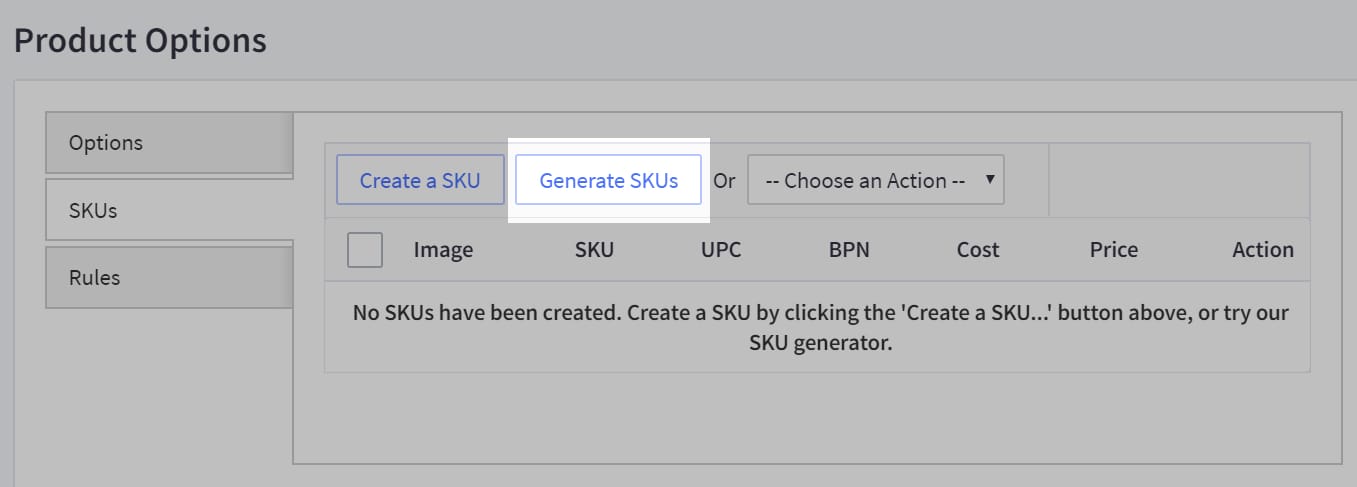
BigCommerce is an ecommerce platform where merchants can build and host their own direct-to-consumer stores.
BigCommerce has a native SKU generator built-in, which can create SKUs based on a few established option types including:
- Color
- Size
- Multiple choice
- Product pick list
- Swatch
Mark all options as Required by editing the Option Set. Note that there is a platform limit of 600 SKUs per product.
From your BigCommerce dashboard, go to Product Options then SKUs. Click on Generate SKUs, and you’ll see a pop-up where you can change your name settings.
Once complete, the pop-up will close and you’ll see SKUs for each product variant, which are saved automatically.
Price: Free (with a BigCommerce subscription)
2. 3Dsellers – Easy-to-use web-based SKU generator

3Dsellers is a suite of eBay selling tools that also provides multiple free ones, including an eBay fee calculator, PayPal fee calculator, free email templates, and a SKU generator.
The 3Dsellers SKU generator allows merchants to select the number of characters for each segment, organize their SKU attributes in any sequence they’d like, and add variations.
It also allows for custom selections, such as removing vowels, keeping everything lowercase, or making everything capital letters.
The easy-to-use tool then generates SKUs in a window below the data input section, ready for export to a CSV.
Price: Free
3. Logiwa – SKU generation within a cloud fulfillment platform
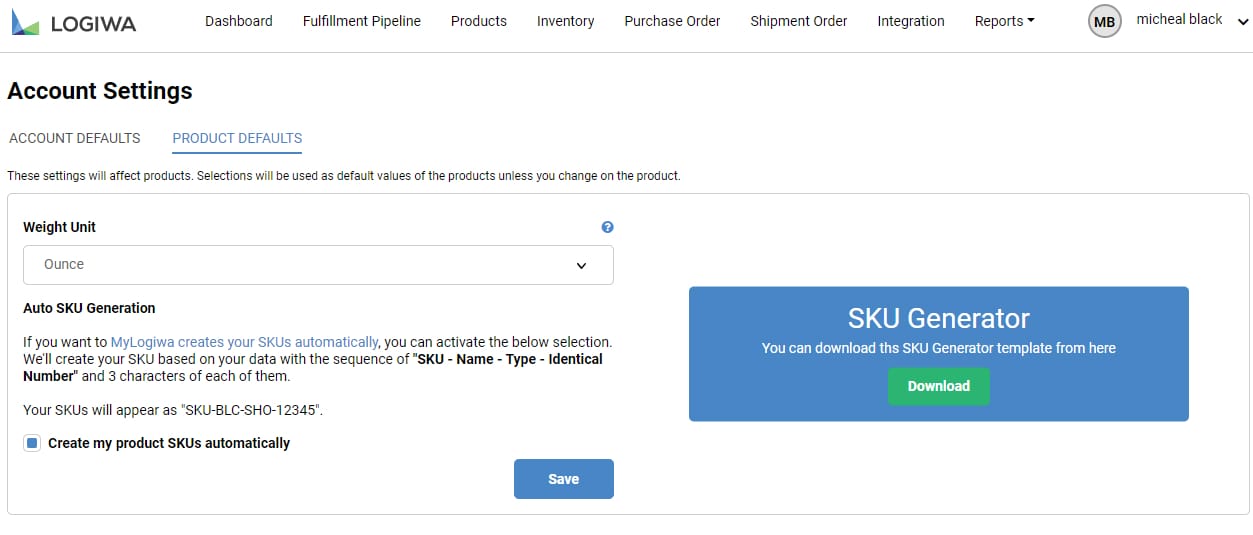
Logiwa is a cloud fulfillment platform that offers an internal SKU generation tool, as well as a manual SKU generation template.
Logiwa users can opt to have the software create product SKUs automatically by going to Account Settings and then the Product Defaults screen.
Once there, check off the option to Create my product SKU automatically.
The Logiwa system will create SKUs using the following system:
- “SKU” as a prefix
- Product name
- Product type
- Identical number for the product
- 3 characters for each of the field
- A dash as a separator
For example, if you have a product named “Coral Ring” under “Accessories,” your SKU would look like: SKU-COR-ACC-123456
Price: Free
4. Katana – Downloadable spreadsheet incorporating SKU parameters
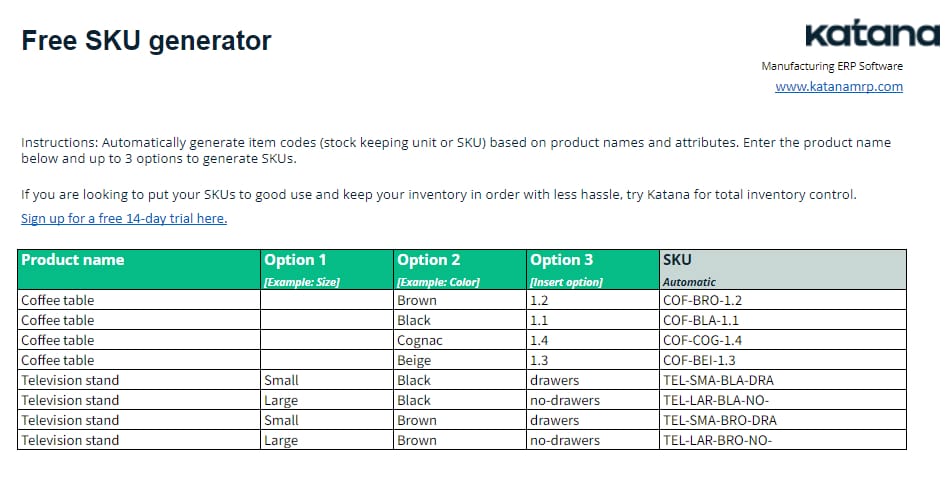
Katana provides manufacturing ERP software with real-time inventory management and planning. They provide a free Excel SKU generator available for download.
The generator allows for a product name followed by three other options of the merchant’s choosing.
Merchants have discretion when it comes to what makes the most sense to utilize these for, such as size, color, or numericals.
Price: Free
5. Gorgias – Web-based SKU generation for any platform
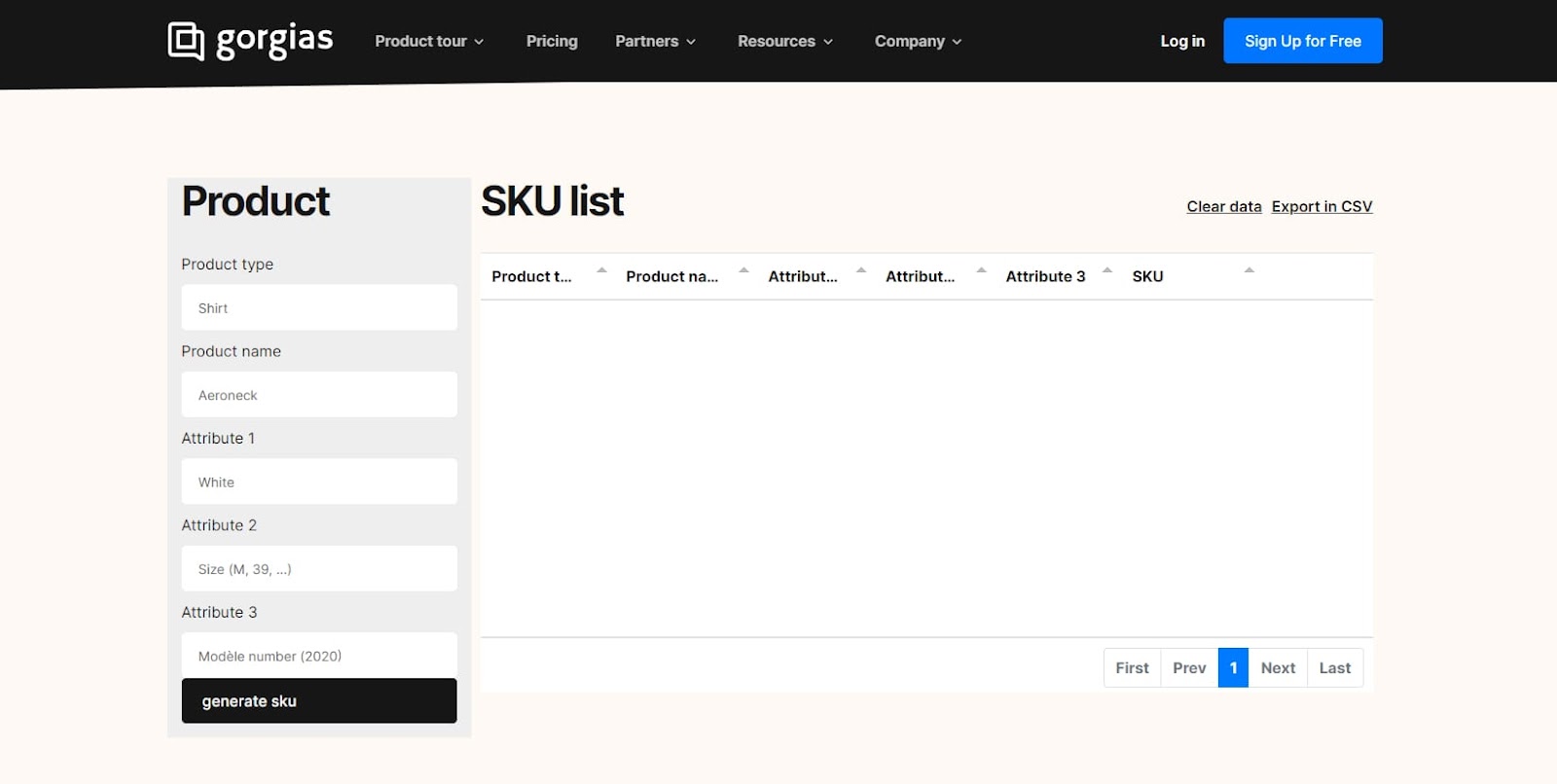
Gorgias is a popular customer service tool for ecommerce merchants.
They created a useful free SKU generator within their website that you can access upon giving your email address.
You can input your product type, product name, and up to three attributes and have their tool generate a SKU for that item.
Once complete, you can opt to export the SKUs with their corresponding data into a CSV file.
Price: Free
6. SKUGen – The best SKU generator app for Shopify sellers
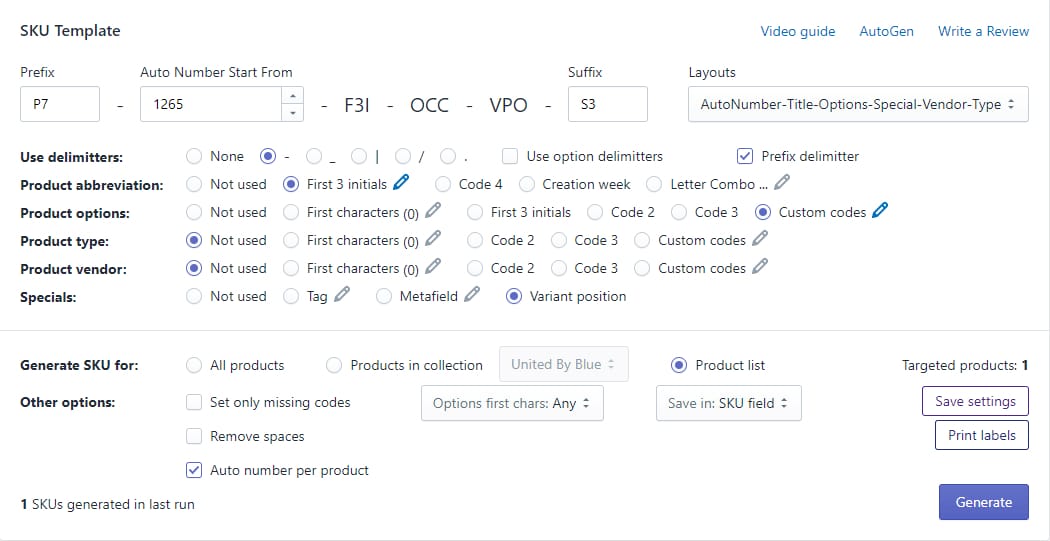
The SKUGen app was built by WebShop Assist, and is a Shopify app that can create SKUs using a customizable ruleset.
For example, you can opt to have prefixes, product abbreviations, automatic numbers for uniqueness and more.
You can also generate a SKU right from the list of your products in Shopify.
Price: Free, with paid options
7. Zoho – Online SKU generator utilizing set patterns
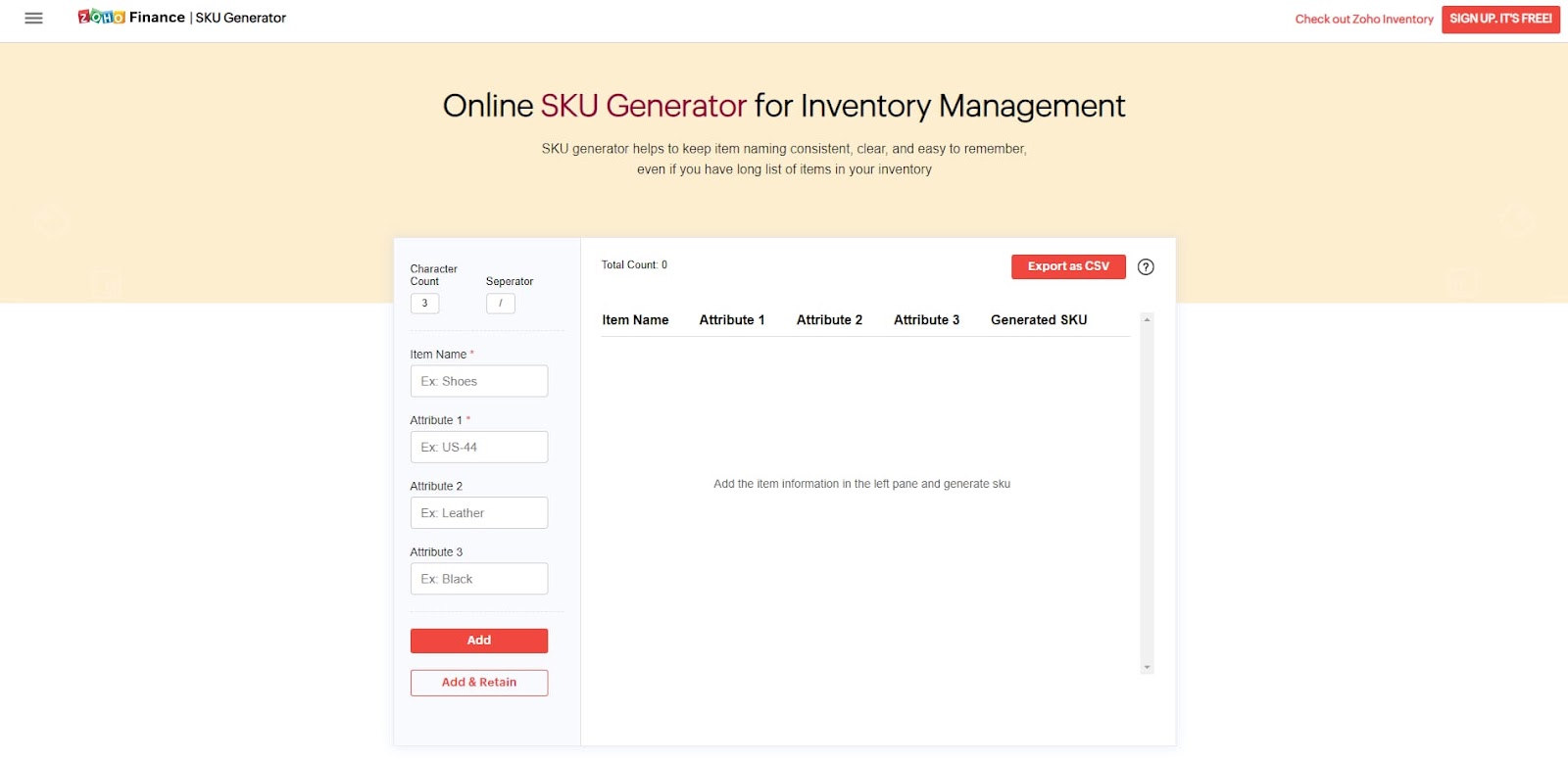
Zoho offers a suite of SaaS tools and applications to run a business, including a customer relationship manager, email service, customer help desk, financial tools, and more.
One of their solutions is a free SKU generator that uses a pattern-based system where you decide the sequence of characters involved.
SKUs are automatically created for that item, listing all of the SKUs in one area for you to download.
The patterns and rules you set remain consistent for your group, ensuring that all of your items are logically marked. Users can also save old lists to build upon current inventories.
Once you’ve finished creating your SKUs, you can export them as a CSV to upload to Amazon or your sales platform of choice.
Price: Free
8. MageCloud – The best SKU generator tool for Adobe Commerce stores

MageCloud is a platform-as-a-service (PaaS) with dedicated Adobe Commerce (fka Magento) servers, custom domains and themes, and extensions to make creating your Adobe Commerce store a breeze.
They also provide an automated SKU generator designed to integrate seamlessly with Adobe Commerce.
With excellent reviews and a clean interface, the tool lets you generate SKU tags for your own products using codes with numbers and letters and a wide variety of different rules you specify.
Price: Free
9. Primaseller – Upload and import SKUs as a CSV
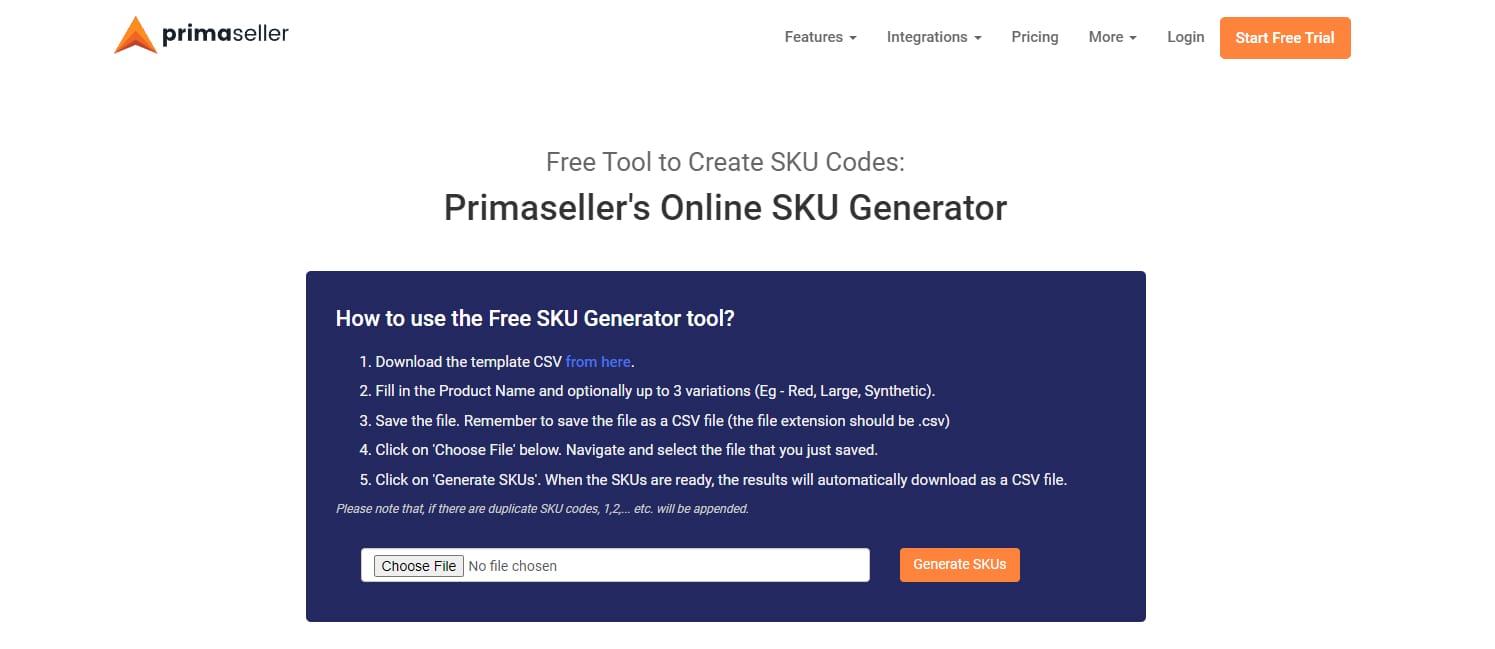
Primaseller is a multichannel selling tool that provides inventory, order, warehouse, and purchase management features alongside point-of-sale software and inventory control systems.
They created a free SKU generator tool wherein you can fill in your data in their pre-built template, upload it into their tool, and get ready-made SKUs in return as a CSV file.
Price: Free
10. Easy Auto SKU Generator for WooCommerce – The best SKU generator for WooCommerce
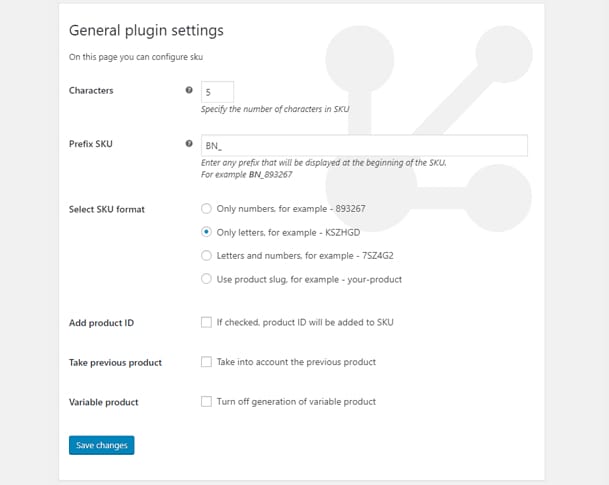
Another automatic SKU generator WooCommerce users can leverage is the Easy Auto SKU Generator for WooCommerce.
This tool automatically generates SKUs upon product creation and is smart enough to not auto-generate SKUs for products with existing ones.
It supports different SKU formats, such as numbers only, letters only, or a mix, and you can set prefixes and the number of characters in your SKU.
Price: Free
#cta-visual-pb#<cta-title>You see SKUs, but your customers see products<cta-title>Try Shogun Page Builder to create product pages as unique as your SKUs with page elements that drive conversions.Start building for free
Best practices for SKU generation
Whether you’re creating SKUs manually or with a SKU generator you want to follow some established best practices.
1. Use a SKU generator
A SKU generator simplifies the entire process.
While it may be easy to manually create SKUs when you’re a small startup, manual creation isn’t really a scalable process—especially not for enterprise brands with a rapidly expanding catalog.
Even if you can’t find software to assist with SKU generation, consider using a third-party free SKU generator such as the ones above that can read your product options and quickly generate logical SKUs for you.
Alternatively, you can use a spreadsheet with formulas to help simplify the SKU generation process.
Logiwa offers a free SKU generator spreadsheet template (seen below) that generates SKUs automatically based on the data you add for products and their options.
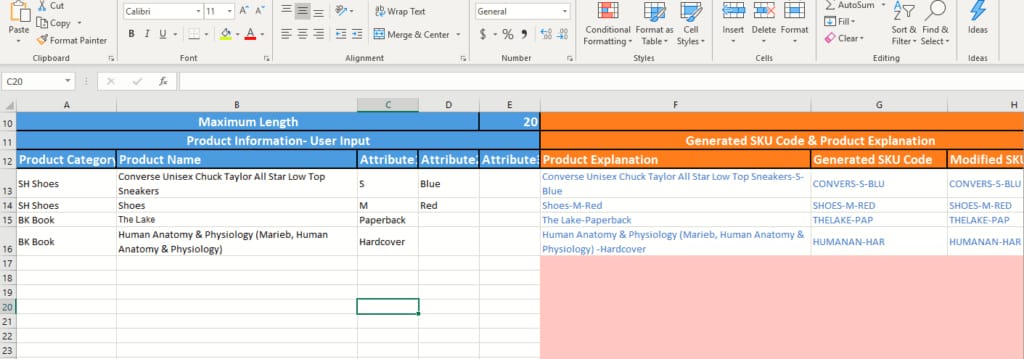
2. Create a coding system
A coding system is an integral part of SKU generation.
While randomly generated numbers can provide unique SKUs, it can make SKU referencing difficult later when you’re analyzing data or need to add SKUs to variations within a specific product set.
Create an established code that applies to key item attributes and product types.
These are usually abbreviations that are always used for every iteration of a brand, product type, category, attribute, etc.
For example, you can create established codes for color, brands, product sizes, and more.
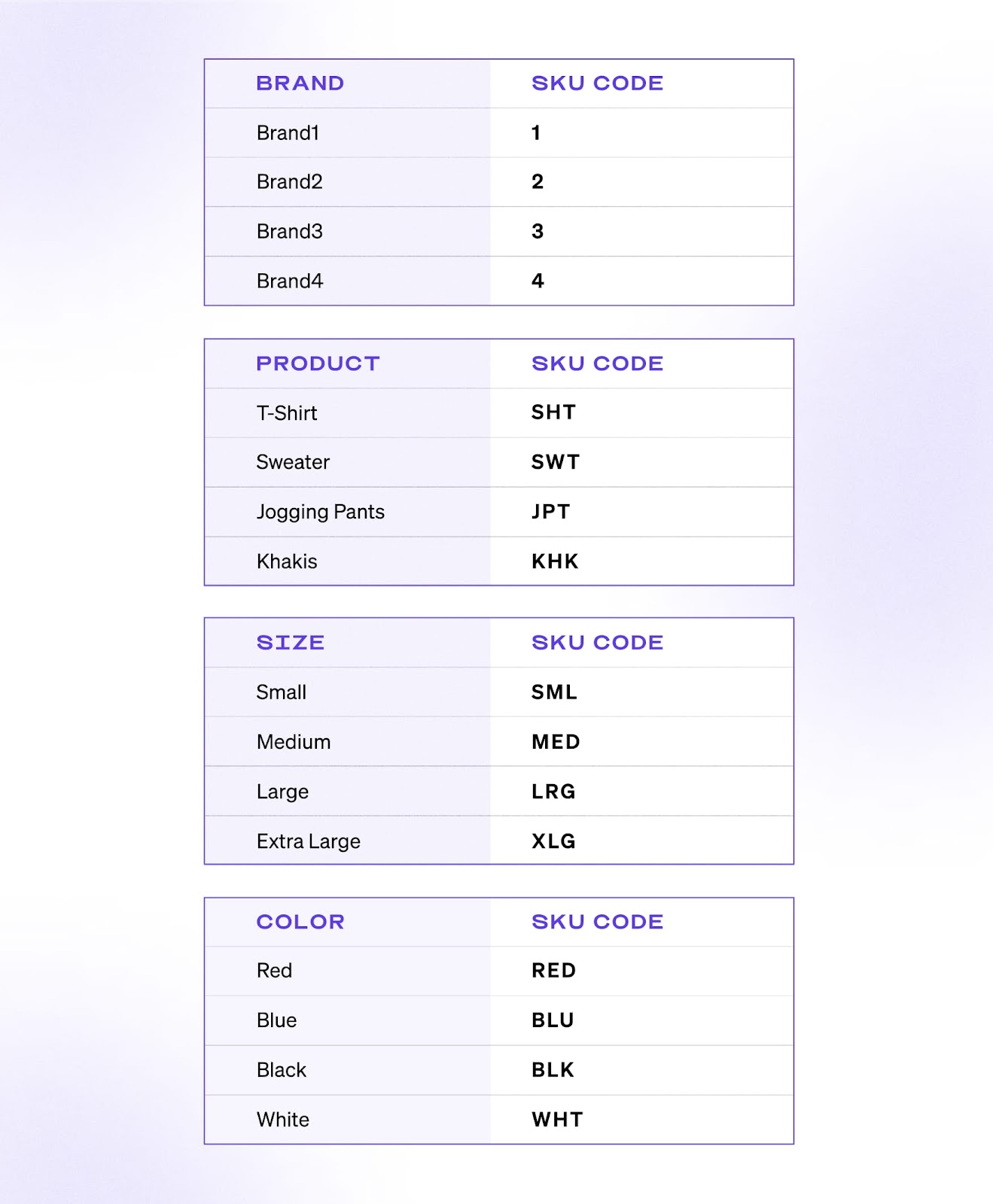
Using the tables above, we can create a SKU that tells us the following attributes based on the codes above.
3-KHK-SML-WHT = Small white khakis from brand 3This coding system and a standard format ensures that your SKUs are always easy to understand no matter who looks at them.
Once you have an established coding system, make it accessible to your team for reference and ensure it’s an established part of training for all of your employees—not just those who handle and ship your products within the warehouse.
Tip: Try to keep each code at two to three alphanumerics to avoid overly lengthy SKUs.
3. Establish a standard format
Whether using a SKU generator or manual process you should establish a standard format.
This way interpretation of your SKUs is never questioned if you have codes within your SKU that could be misread.
The best approach is to start with the highest or most important product information first and end the SKU with codes applicable to the options in product variants.
Developing a hierarchy of information will ensure all SKUs follow the same format.
Options with more variations should be at the end while options with only a few options (like gender) should go at the beginning—but after the product category and product type.
For example, you would align your codes like this:
Brand > Product Category > Product Type > Gender > Material > Size > ColorOnce you have a standard format, always generate SKUs in the same format.
This makes it easy for your teams to understand what each code represents when trying to match a SKU to the product they are picking or shipping.
In the interest of keeping SKUs short, try to limit the number of code sets you include. You only need enough to identify the specific product variation.
After all, it’s a SKU, not a product description.
If you must include a lot of detail in your SKU formats, find ways to create SKU codes no longer than three characters. Ideally, aim for two characters.
Or find ways to make numbers work for you instead of using multiple characters.
For example, if you have nine different brands you could assign them the numbers 1-9 instead of using a three or four-letter abbreviation for the brand name.
4. Avoid using similar letters and numbers
SKUs are read frequently by your team members, often at a glance.
They also may need to be typed by hand fairly often. So, avoid using letters and numbers that can be easily misread because they look similar.
For example, it’s too easy to mistake a capital ‘i’, a lowercase ‘L’, and the number ‘1’. The same goes for the number ‘0’ and the letter ‘O’.
5. Make SKUs easy to understand and identify
SKUs help make heads or tails of data while also streamlining the process for your team members who spend their days stocking, picking, packing, and shipping products.
This is why it’s essential to create a coding system and format everyone can understand. Remember, it’s not just your warehouse crew that needs to interpret SKU data.
Your customer service team will inevitably need to cross-reference this data when helping customers.
Your marketing team will need to be able to identify products based on SKU for analyzing data as well as creating product-specific discounts within your ecommerce platform.
An easily-readable SKU can be rapidly sorted and spotted within spreadsheets full of data, and also easily filtered when reviewing large data sets.
6. Don’t start SKUs with the number 0
Ideally, you’re not using the number 0 at all to avoid confusion with the letter ‘o’.
However, if you must, never use it to start your SKU. Some software may interpret the number 0 as nothing and could omit the first digit.
For example, if you use a SKU generator and your SKU for a particular brand of black hat reads as “023-HT-BLK” then one of the software integrations you use may interpret that as “23-HT-BLK”.
Since you never know when you may add new software or change your warehouse management system, it’s best to avoid putting yourself in that situation.
7. Ensure each SKU is unique
A good warehouse management system will automatically flag a conflict if you try to create a SKU or load a product into the system when that SKU already exists for another product.
Don’t assume that your software will catch it though.
If you’re using a SKU generator combined with good coding and architecture practices, you shouldn’t have to worry about duplicating SKUs.
For manual SKU creation and manually loading SKUs into your products, be sure to double-check your SKU codes—especially when adding new products and new option codes to your architecture.
8. Don’t use spaces
Each code that makes up your SKU should be separated in order to make codes easier to read. However, never break up your SKU using spaces.
This can create errors in reading SKUs when a person isn’t certain if multiple sets of numbers apply to the same string or SKU.
Also, some software may interpret a space as a hard stop and ignore any data that comes after the space.
Instead, use a dash between each code in your SKUs. A good SKU generator should do this automatically but be mindful of using dashes when manually creating and entering SKUs.
How to use SKUs
Because SKUs are internal and unique to your business, they can be used to help you analyze data around product performance, trends, and inventory control.
Be sure to generate SKUs with an architecture based on the most important indicators you want to track.
For example, if your customers care more about size than color, prioritize the code for size.
Once you have developed a SKU architecture that suits your business, there are several ways to use them, ranging from product promotion, growth planning, cross-selling and upselling, and more.
1. Targeted product promotion

Analyzing the data around how SKUs are moving makes it easier to target product-specific promotion.
When you can easily identify the biggest generators of profit you can create campaigns and custom landing pages to promote them.
You can also give those products a featured spot on high-traffic pages where customers can easily find them in order to drive targeted traffic.
2. Improved inventory forecasting
When every product and its variations have a designated, unique SKU it becomes infinitely easier to forecast your sales.
Forecasting is a must if you want to meet customer demands and it’s a critical step to avoid running out of inventory on popular products during holidays or promotions.
When customers can’t find the product they want, they’ll try to find a substitute. Worst case: they’ll find the product at another retailer.
Harvard Business Review studied more than 70,000 global consumers to discover that a large segment of customers will take their business elsewhere.
In fact, 7% to 25% of consumers faced with a stock-out will continue shopping but won’t buy a substitute for their desired item at the store; 21% to 43% will actually go to another retailer to find the product.
If you’re not using a SKU generator and structured process to forecast inventory needs, then you can lose nearly half of intended purchases due to being out of stock.
Those abandoned purchases translate into sales losses of about 4% for a typical retailer.
A SKU generator lets you get granular when forecasting
A key reason SKUs can be so helpful goes beyond identifying fast-moving products to reorder.
For the purpose of forecasting, monitoring SKUs lets you analyze how customers are buying your products. You can then identify the attributes and variations most attractive to their respective customer segments.
“…most of the time customers don’t buy products; they buy a bundle of attributes,” writes Marshall Fisher and Ramnath Vaidyanathan in an article for Harvard Business Review.
“Think about the last time you bought a TV. Did you say, ‘I want TV X’? Or did you think about screen size, resolution, price, LCD versus plasma, and brand?”
Tracking the sale of existing SKUs to forecast the demand of product variations gives you a more scientific approach to testing campaigns—rather than just trying to promote product variants on a hunch based on how parent products are selling.
3. Expeditious order picking
As the number of products in your warehouse grows, the longer it takes for your team to locate those products.
Furthermore, as you start carrying more product variations your staff is more likely to pick the wrong item. This makes for a bad customer experience.
Using a SKU generator brings efficiency to your warehouse while reducing the potential for human error.
For example, let’s say you sell video game consoles in identical or very similar packaging with the only variation being the size of the hard drive.
Having a unique SKU generated for each variation makes it easier for your picker to select the right product when visually similar or identical boxes might otherwise create a customer return issue.
Help your team find products faster
As an added bonus, you can position products in your warehouse for faster routing with SKU profiling.
This way, popular items are in the easier-to-reach locations while slow-moving products are moved toward the rear of your warehouse.
#cta-paragraph-pb#Want to learn more about inventory management for your Shopify store? Check out our guide to Shopify inventory management to find the most useful apps, learn best practices, and more.
SKU generation FAQs
Why are SKUs important?
SKUs are vital for every ecommerce business because they are unique product identifiers that help you keep your inventory organized, manage orders and promotions, and improve your customer experience.
These numbers are useful for distinguishing one product from another while maintaining a naming convention that’s easy for your team to understand internally.
Can more than one product have the same SKU?
No, it is a unique identifier that also considers different variations (and combinations thereof) of a certain item, which means each item’s SKU must be different.
Do different businesses use the same SKUs?
Traditionally, SKUs are seen as business-specific identifiers.
SKUs vary from one business to another because you can put whatever data you like in the SKU field on the spreadsheet.
Your ecommerce platform will pull that data and use it to populate the SKU field when each product is created.
Likewise, if you’re manually creating each product in your store—common for those with relatively small catalogs—you can type in the SKU when filling in the other product fields.
Tip: Brands should not use the manufacturer SKU or any other “inherited” SKU.
Consider this: If you use your manufacturer’s SKU and then begin working with a different or additional manufacturer, you’ll have two different naming conventions for your SKUs, causing unnecessary confusion.
Are SKUs and barcodes the same thing?
No. A barcode is a printed code on a product that looks like a series of scannable lines.
Barcodes are typically printed directly on products and incorporated into the packaging. On the other hand, SKUs may or may not be printed directly on product packaging.
Barcodes and SKUs are also different in the way they are created. Barcodes are on all products and include the UPC, whereas SKUs are unique to a business or seller.
Do SKUs have to be all capitalized?
Since SKUs are a custom product code that varies from business to business, the structure and conventions depend on what you’ve set as your business standard.
For example, some companies only use numbers, some use all capitalized letters, and some use a mix of lower-case letters and numbers.
Streamline your processes with a SKU generator
In addition to using a SKU generator, we recommend taking advantage of other apps to help you manage your inventory, organize orders, and ensure timely deliveries.
A SKU generator bundled with warehouse and inventory management software makes it much easier to read and interpret data behind the scenes.
They also help reduce overhead costs and improve customer satisfaction by reducing the amount of human error that occurs naturally with packing and shipping products to customers.
Even when using a SKU generator, the best practices listed above ensure that you’re creating easily readable SKUs with an architecture that will scale with your business even when you’re faced with SKU proliferation.
#cta-visual-pb#<cta-title>Automate SKUs, ideate pages<cta-title>Create stunning product pages for each of your auto-generated SKUs and increase your sales.Start building for free

Rachel Go
Rachel is a remote marketing manager with a background in building scalable content engines. She creates content that wins customers for B2B ecommerce companies like MyFBAPrep, Shogun, and more. In the past, she has scaled organic acquisition efforts for companies like Deliverr and Skubana.



